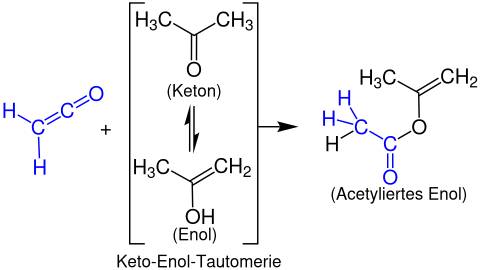Ketene

In organic chemistry, a ketene is an organic compound of the form RR'C=C=O, where R and R' are two arbitrary monovalent chemical groups (or two separate substitution sites in the same molecule).[1] The name may also refer to the specific compound ethenone H2C=C=O, the simplest ketene.[2]
Although they are highly useful, most ketenes are unstable. When used as reagents in a chemical procedure, they are typically generated when needed, and consumed as soon as (or while) they are produced.[1]
History
Ketenes were first studied as a class by Hermann Staudinger before 1905.[3]
Ketenes were systematically investigated by Hermann Staudinger in 1905 in the form of diphenylketene (conversion of -chlorodiphenyl acetyl chloride with zinc). Staudinger was inspired by the first examples of reactive organic intermediates and stable radicals discovered by Moses Gomberg in 1900 (compounds with triphenylmethyl group).[4]
Properties
Ketenes are highly electrophilic at the carbon atom bonded with the heteroatom, due to its sp character. Ketene can be formed with different heteroatom bonded to the sp carbon atom, such as
Ethenone, the simplest ketene, has different experimental lengths for each of the double bonds; the C=O bond is 1,160Å and the C=C bond is 1,314Å. The angle between the two H atoms is 121.5°, similar to the theoretically ideal angle formed in alkenes between sp2 carbon atom and H substituents.[5]
Ketenes are unstable and cannot be stored. In the absence of nucleophiles with which to react, ethenone dimerises to give β-lactone, a cyclic ester. If the ketene is disubstituted, the dimerisation product is a substituted cyclobutadione. For monosubstituted ketenes, the dimerisation could afford either the ester or the diketone product.
Synthesis
Ketene is produced on a commercial scale by thermal dehydration of acetic acid. Substituted ketenes can be prepared from acyl chlorides by an elimination reaction in which HCl is lost:
In this reaction, a base, usually
Ketenes can also be formed from α-diazoketones by the Wolff rearrangement.
Another way to generate ketenes is through
A more robust method for preparing ketenes is the
Reactions and applications
Due to their
Formation of carboxylic acid esters
By reaction with alcohols,
Formation of carboxylic anhydrides
Ketenes react with a carboxylic acids to form
Formation of amides
Ketenes react with ammonia and amines to give the corresponding amides:
Hydrolysis
By reaction with water, carboxylic acids are formed from ketenes
Formation of enol esters
Enol esters are formed from ketenes with
to form a propen-2-yl acetate:Dimerisation
At room temperature, ketene quickly dimerizes to diketene, but the ketene can be recovered by heating:
[2+2]-cycloaddition
Ketenes can react with
Applications
Ketenes are generally very reactive, and participate in various
They will also undergo [2+2] cycloaddition reactions with electron-rich alkynes to form cyclobutenones, or carbonyl groups to form beta-lactones. With imines, beta-lactams are formed. This is the Staudinger synthesis, a facile route to this important class of compounds. With acetone, ketene reacts to give isopropenyl acetate.[1]
A variety of
Ethyl acetoacetate, an important starting material in organic synthesis, can be prepared using a diketene in reaction with ethanol. They directly form ethyl acetoacetate, and the yield is high when carried out under controlled circumstances; this method is therefore used industrially.
See also
- Ynol
- Thioketene
References
- ^ ISBN 978-3527306732.
- ISBN 9780471276708.
- .
- ^ Thomas T. Tidwell, The first century of Ketenes (1905-2005): the birth of a family of reactive intermediates, Angewandte Chemie, Int. Edition, Band 44, 2005, S. 5778–5785
- .
- doi:10.1071/CH14714.
- PMID 24038393.
- ISSN 1099-0682.
- ISBN 3871449024
- ISBN 9783540300304
External links
 Media related to Ketenes at Wikimedia Commons
Media related to Ketenes at Wikimedia Commons










